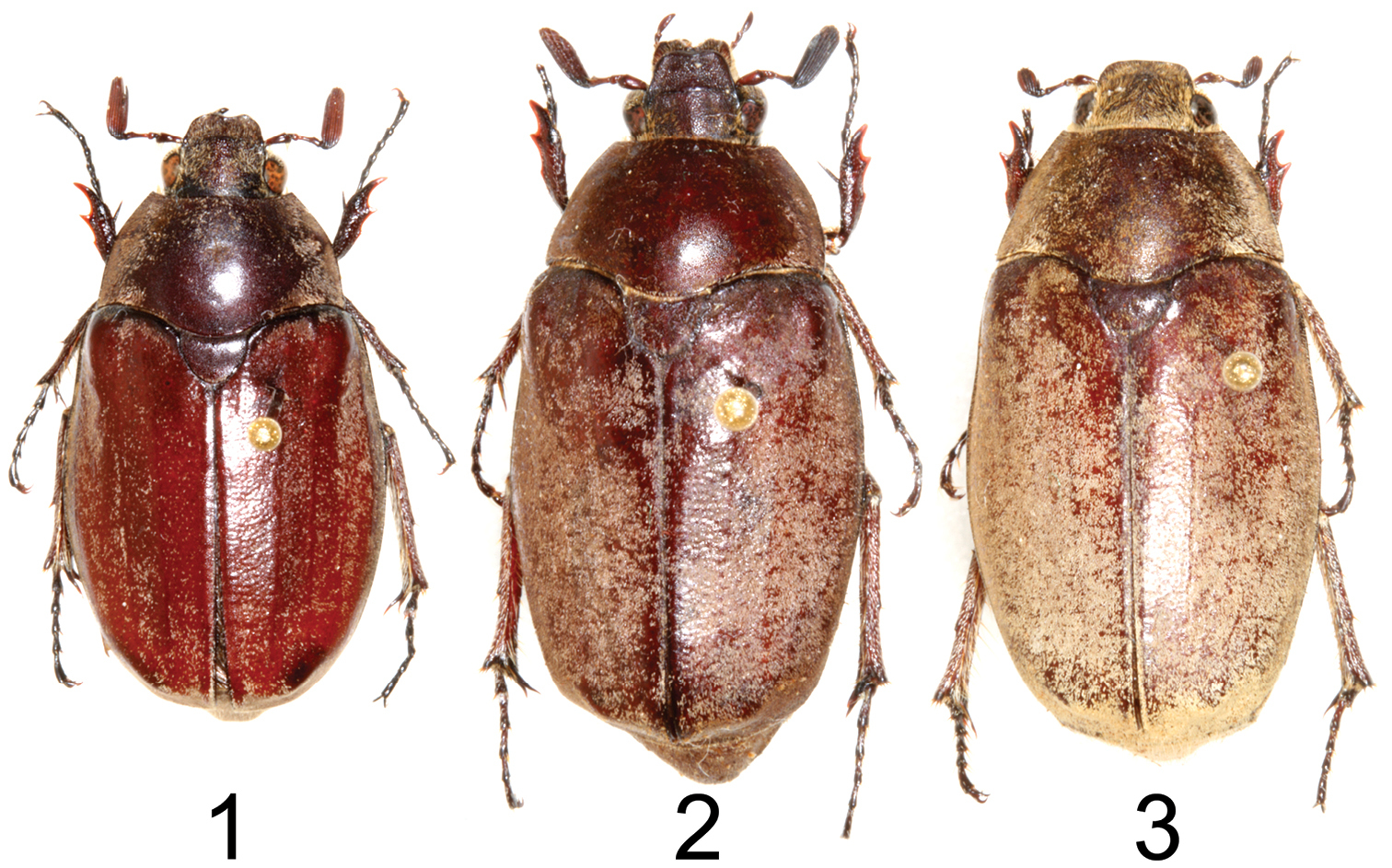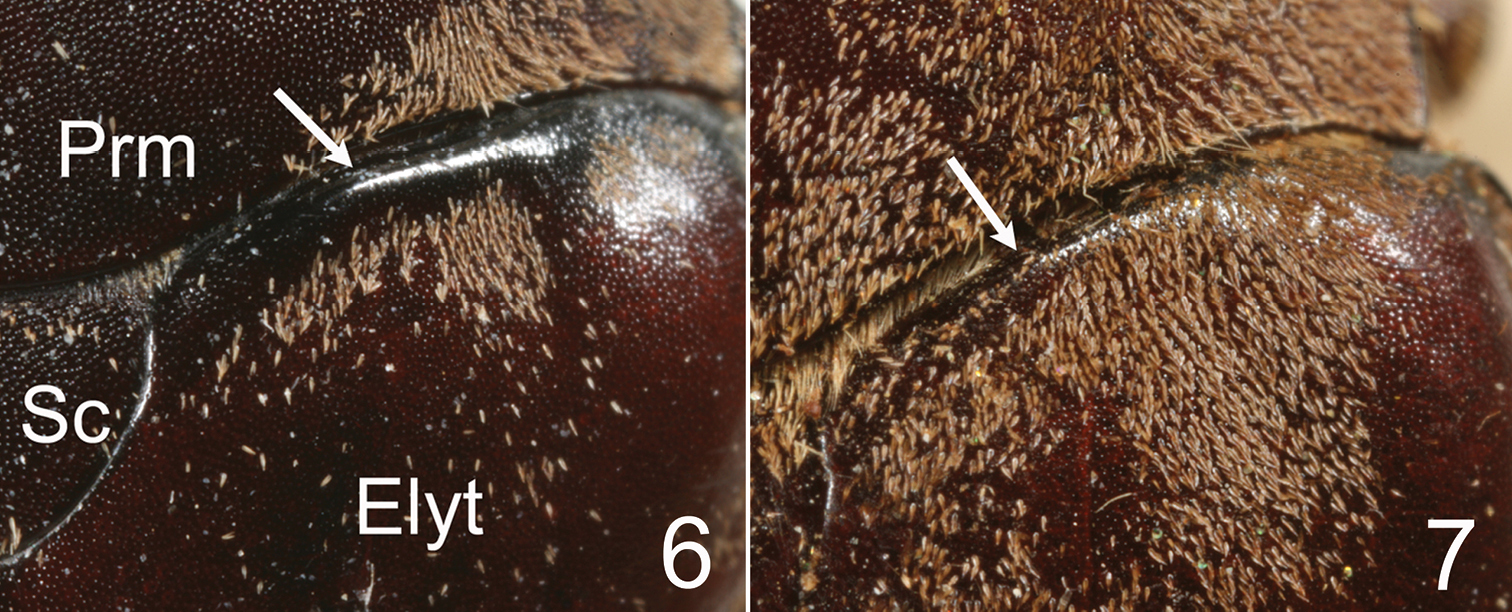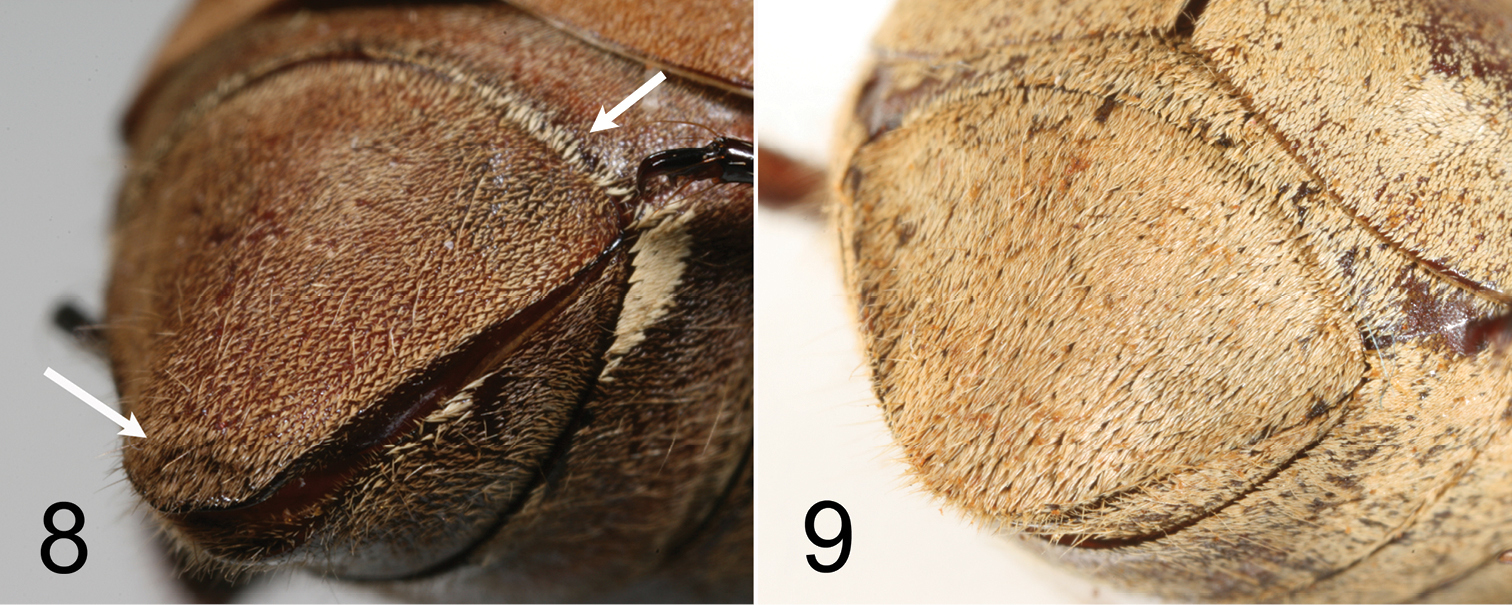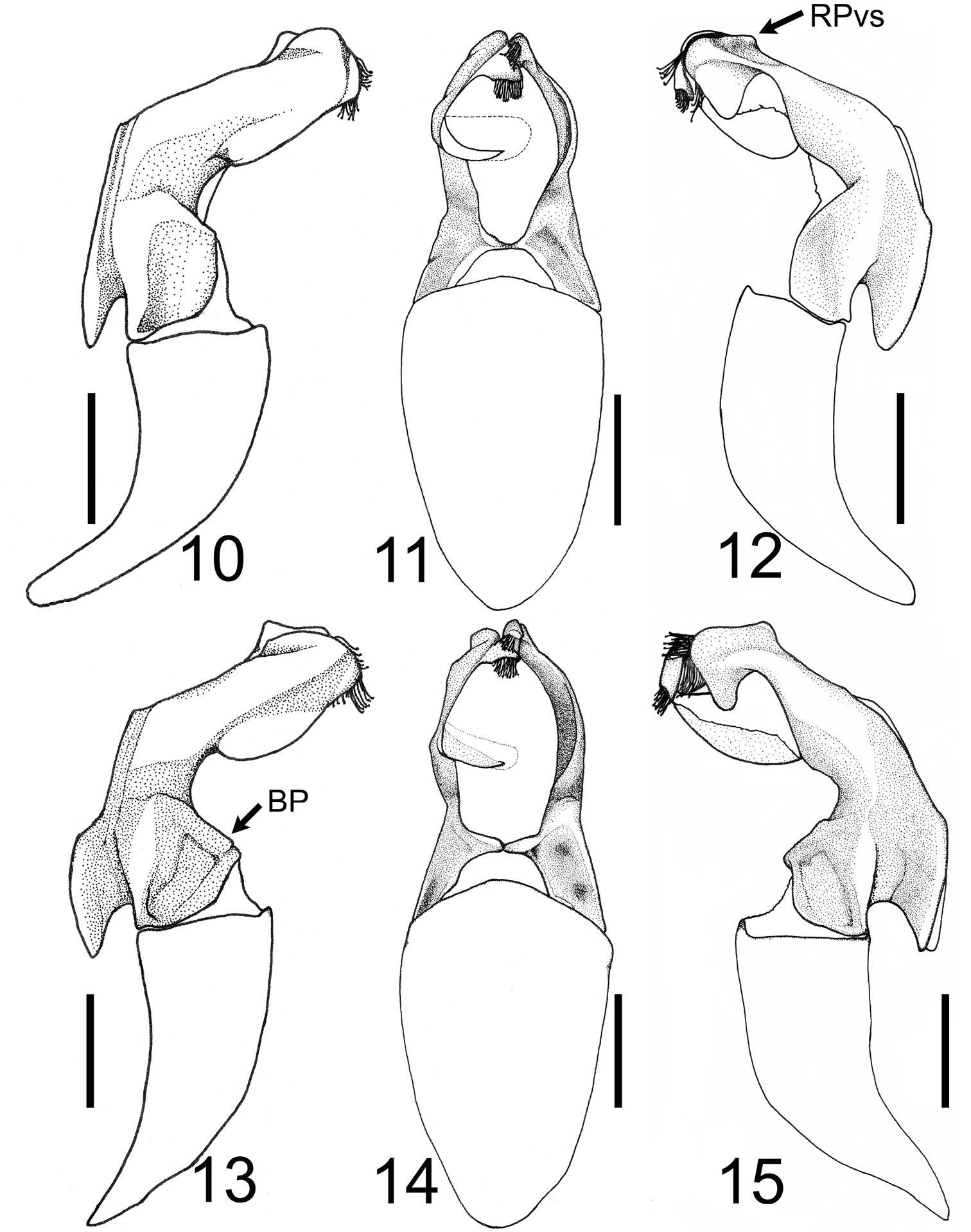






(C) 2012 Chun-Lin Li. This is an open access article distributed under the terms of the Creative Commons Attribution License 3.0 (CC-BY), which permits unrestricted use, distribution, and reproduction in any medium, provided the original author and source are credited.
For reference, use of the paginated PDF or printed version of this article is recommended.
Two new species of the Oriental scarab genus Tocama Reitter, 1902, Tocama laosensis sp. n. and Tocama procera sp. n., are described from Indochina with diagnoses, distributions, remarks and illustrations. A key to the species of the genus is provided with a checklist with several nomenclatural changes: Hoplosternus tonkinensis Moser, 1913 is transferred to Tocama; Hoplosternus pygidialis Moser, 1915 syn. n., Tocama atra atra Keith, 2006 syn. n. and Tocama atra reichenbachi Keith, 2007 syn. n. = Tocama tonkinensis (Moser).
Tocama, new species, new synonym, new combination, Scarabaeidae, Melolonthinae, Indochina
The Oriental genus Tocama Reitter, 1902 is a small scarab beetle group that includes seven species, two of which are newly described here. Species of Tocama are distributed in southeastern Asia, eastern and southern China, and Taiwan. Tocama species are 14.0–30.5 mm in length, castaneous to blackish brown beetles that are dorsally covered with dense, tiny, brownish grey or yellowish brown, scale-like setae. The genus Tocama was first proposed by
Specimens examined in this study were borrowed from the institutions (name of curators in acknowledgments) listed in the section of type material or came from the first author’s personal collections.
The preparation of specimens and morphological terms used in this paper follow
1. Tocama formosana (Yu, Kobayashi & Chu, 1998)
Melolontha formosana Yu, Kobayashi & Chu 1998: 206. Original combination.
Distribution. Taiwan.
2. Tocama laevipennis (Blanchard, 1851)
Hoplosternus laevipennis
Hoplosternus squamulatus
Distribution. China; Vietnam; Laos (new country record with a female collected in Vangvien, Laos, in the first author’s collections).
3. Tocama laosensis Li & Keith, sp. n.
Distribution. Laos.
4. Tocama procera Li & Keith, sp. n.
Distribution. Vietnam.
5. Tocama rubiginosa (Fairmaire, 1889)
Melolontha rubiginosa
Melolontha albidiventris
Distribution. China.
6. Tocama siamensis Keith, 2006: 224
Distribution. Thailand.
7. Tocama tonkinensis (Moser, 1913), comb. n.
Hoplosternus tonkinensis
Hoplosternus pygidialis Moser, 1915: 589, syn. n.
Tocama atra atra Keith, 2006: 225, syn. n.
Tocama atra reichenbachi Keith, 2007: 338, syn. n.
Distribution. China; Vietnam; Laos; Myanmar.
urn:lsid:zoobank.org:act:6C4AB152-9560-4422-A89C-B44BF06B6D21
http://species-id.net/wiki/Tocama_laosensis
Figs 1, 4, 6, 10–12male. LAOS: Lak 20, 22–26/VIII/1996, by local collector (deposited at Museum für Naturkunde der Humboldt Universitat (ZMHB), Berlin, Germany)
Southern Laos: Champasack province, Lak 20, 15°01’N, 105°90’E.
Tocama laosensis is distinguished from other congeners by the following combination of characters: body medium sized, thin, pronotum flat when viewed laterally (Fig. 4); head, pronotum and scutellum blackish brown, elytra dull castaneous; surface of pronotum, scutellum and elytra covered with tiny brownish grey setae, setae on vertex about 4 times length of those on pronotum and elytra; basal margin of elytra between scutellum and humeral umbone broadly ridged (Fig. 6); apical ridge of pygidium impressed and becoming concave inwardly along plane of disc; mesometasternal process vestigial; metepimeron and sides of abdominal sternites 1–6 with maculation consisting of brownish white, scale-like setae; male genitalia as in Figures 10–12.
Males(Figs 1, 4): BL: 20.0 mm; BW: 12.0 mm; CL/BL=1.1; PgW/L= 1.32. Body thin, pronotum flat when viewed laterally (Fig. 4). Head, antennae, pronotum, scutellum and venter blackish brown; tarsomeres black; elytra dull castaneous; dorsal surface of body covered with minute, brownish grey setae. Head: Surface densely and coarsely punctate, each puncture with a seta, setae on clypeus thinner and shorter than those on vertex. Clypeus rectangular, bordered, with center apex emarginated; vertex slightly convex with setae about 4 times length of those on pronotum and elytra. Antennal club straight, subequal in length to basal segments. Labrum strongly bilobed at middle, symmetrical, each lobe rounded apically. Mentum with anterior margin moderately bilobed, surface sparsely setigerous, setae moderately long. Maxillary palpi short, apical palpomere about half length of antennomere 3. Pronotum: wider than long, widest at base, depressed when viewed laterally (Fig. 4); lateral margins well bordered, weakly developed anterior to scutellum; surface densely, evenly punctuate; punctures fine, each with a scale-like, tiny seta about 3 times length of diameter of puncture. Scutellum semicircular, surface with punctures and setae similar to those on pronotum. Elytron: Widest at middle; surface rugose with 4 weakly developed, punctate costae, costae 1–3 (starting from suture) complete, costa 4 vestigial; overall punctures and setae same as those on disc of pronotum; basal margin of elytra between scutellum and humeral umbone broadly ridged (Fig. 6). Propygidium: Surface densely punctate, punctures setigerous, setae similar to those on disc of pronotum with a row of more robust setae along apical margin. Pygidium: Lateral margins narrowly flattened. Surface densely punctuate; punctures setigerous, setae scale-like, longer and more robust than those on pronotum, sparsely intermixed with hair-like, long setae (about 3–12 times longer than scale-like setae); pygidial apex truncate and concave inwardly along plane of disc (see Fig. 8 for Tocama procera), apical margin weakly quadrate. Venter: Prosternal process feebly protruding, apex not reaching base of protrochanter. Mesometasternal process vestigial. Metepisternum densely covered with hair-like setae. Metepimeron and sides of abdominal sternites 1–6 with maculation of brownish white, scale-like setae. Middle of abdominal sternites 1–4 almost impunctate, sides densely punctuate; punctures setigerous, setae fine, scale-like, intermixed with hair-like setae that are 3–15 times longer. Legs: Protibia tridentate with basal tooth weakly developed. Pro- and mesofemora flattened, surface hairy; hind femora stout, broad, surface clothed with much shorter, robust setae than those of pro- and mesofemora. Mesotibia with 2 apical spurs equal in length. Metatibia with dorsal apical spur reaching to middle of metatarsomere 2; ventral apical spur of metatibia subequal in length to metatarsomere 1. Parameres: In lateral view (Figs 10, 12), base of parameres (BP) constricted, ventroapical swelling of right paramere (RPvs) weakly developed. Middle of lateral margin smooth when viewed dorsally (Fig. 11).
Dorsal habitus of Tocama spp. 1 Tocama laosensis sp. n., holotype male 2 Tocama procera sp. n., holotype male 3 Tocama procera sp. n., paratype female.
Right lateral view of Tocama spp. 4 Tocama laosensis sp. n., holotype male 5 Tocama procera sp. n., holotype male.
Base of right elytron of Tocama spp. 6 Tocama laosensis 7 Tocama procera. Prm, pronotum; Sc, scutellum; Elyt, elytron.
Right oblique view of pygidium of Tocama procera 8 holotype male. 9 paratype female.
Female unknown.
The species epithet is derived from the name of Laos, wherefrom it is described. This is the first Tocama species from this country and is probably endemic to it.
Tocama laosensis is known from a single male specimen collected by a local collector, and it lacks further information. However, the type locality of the species is the southernmost distribution for the genus so far.
urn:lsid:zoobank.org:act:D919D097-59ED-48B3-8A01-45725D1EB6FD
http://species-id.net/wiki/Tocama_procera
Figs 2, 3, 5, 7– 9, 13–15, 17♂. VIETNAM: Vinh Phu//Tam Dao//19–21/V/1995//coll. M. Satô (deposited at the Natural History Museum (BMNH), London, U. K.).
3 ♂♂ 1 ♀. VIETNAM: Lao Cai province//Sa Pa//May 3–28, 1993//N. Katsura leg. (1♂, deposited in the first author’s collection, CLLI); same locality, 11–14/V/1995// coll. M. Satô (1 ♀, CLLI); same locality, 14. V. 2000// S. Nomura leg. (1♂, deposited at the National Science Museum (NSMT), Tokyo, Japan); Tonkin// Env. de Hoa-Binh// J.Laisi_1902// ex Museo Oberthur (1♂, deposited at the Institut Royal des Sciences Naturelles de Belgique (ISNB), Bruxelles, Belgium)
Northern Vietnam: Vinh Phu province, Tam Dao, 21°46'N, 105°65'E.
Based upon the shared characters of the presence of metepimeral maculation (as well as lacking metepisternal maculation (Fig. 17)), apex truncate of the pygydium and shape of the parameres, Tocama procera most closely resembles Tocama laosensis. Tocama procera differs from Tocama laosensis by the thickness of the pronotum when viewed laterally (flat in Tocama laosensis (Fig. 4), convex in Tocama procera (Fig. 5)), the shape of the anterior margin of the mentum (moderately bilobed in Tocama laosensis, straight in Tocama procera), length of setae on the anterior and lateral margins of the pronotum to length of those on the disc (2–4 times longer in Tocama laosensis, 4–8 times longer in Tocama procera), and the form of the basal margin of the elytra between the scutellum and humeral umbone (broadly ridged in Tocama laosensis (Fig. 6), feebly ridged in Tocama procera (Fig. 7)).
Male genitalia of Tocama spp. 10–12 Tocama laosensis sp. n. 13-15 Tocama procera sp. n. BP, base of parameres; RPvs, ventroapical swelling of right paramere. Scale bar = 1.5 mm.
Males(Figs 2, 5): BL: 20.3–22.9 mm; BW: 11.4–11.8 mm; CL/BsL=1.16–1.18; PgW/L= 1.25–1.33. Body thick, pronotum convex when viewed laterally (Fig. 5). Head, antennae, pronotum, scutellum and venter of body blackish brown, tarsomeres black, elytra dull castaneous, dorsal surface of body covered with minute, brownish grey setae. Head: Surface densely, coarsely punctate, each puncture with a seta, setae on clypeus thinner and shorter than those on vertex. Clypeus rectangular, bordered, emarginated apically; vertex moderately convex, covered with slender, hair-like and robust, scale-like setae, setae becoming longer laterally. Antennal club straight, subequal in length to basal segments. Labrum strongly bilobed at middle, symmetrical, each lobe rounded apically. Mentum with anterior margin straight, surface sparsely setigerous, setae moderately long. Maxillary palpi short, apical palpomere about 2/3 length of antennomere 3. Pronotum: Wider than long, widest at base, moderately convex when viewed laterally (Fig. 5); lateral margins well bordered but weakly developed anterior to scutellum; disc densely, evenly punctuate; punctures setigerous, fine, each with small, scale-like seta about 3 times longer than diameter of puncture, anterior and lateral margins with long, hair-like setae sparsely distributed, about 4–8 times longer than those on disc. Scutellum semicircular, surface with punctures and setae similar to those on pronotum. Elytron: Widest at middle. Surface rugose with 4 poorly developed, punctate costae between suture and humerus, sutural costa (as costa 1) and costae 2–3 complete, costa 4 vestigial; punctures and setae same as those on disc of pronotum; basal margin of elytra between scutellum and humeral umbone feebly ridged (Fig. 7). Propygidium: Surface densely punctuate, punctures setigerous; setae similar to those on disc of pronotum with a row of whitish, more robust setae along apical margin (Fig. 8). Pygidium: Lateral margins narrowly flattened. Surface densely punctate, puncture setigerous; setae scale-like, longer and more robust than those on pronotum, sparsely intermixed with long, hair-like setae (about 3–12 times longer than scale-like setae); pygidial apex truncate and concave inwardly along plane of disc (Fig. 8). Venter: Prosternal process moderately protruding, reaching base of protrochanter. Mesometasternal process feebly protruding. Metepisternum densely with hair-like setae (Fig. 17). Metepimeron and sides of abdominal sternites 1–6 with maculation consisting of brownish white, scale-like setae. Middle of abdominal sternites 1–4 almost impunctate with sides densely punctate, punctures setigerous, setae fine, scale-like, sparsely intermixed with hair-like setae 3–15 times longer. Legs: Protibia tridentate with basal tooth weakly developed. Pro- and mesofemora flattened, surface setose; hind femur more stout, surface clothed with much shorter, robust setae than those on pro- and mesofemora. Mesotibia with 2 apical spurs equal in length. Metatibia with dorso-apical spur reaching middle of metatarsomere 2; ventral apical spur of metatibia subequal in length to metatarsomere 1. Parameres: In lateral view, base of parameres (BP) strongly broadened, ventroapical swelling of right paramere (RPvs) distinctly developed (Figs 13, 15). Middle of lateral margin convex when viewed dorsally (Fig. 14).
Right metepisternum of Tocama spp. 16 Tocama tonkinensis 17 Tocama procera sp. n.
Female (Fig. 3). BL: 22.0 mm; BW: 11.0 mm; CL/BsL= 0.63; PgW/L= 1.41. Similar to male except for setae being yellowish brown (brownish grey in males), more robust and denser on elytral apical depressed area, propygidum, pygidium and abdominal sternites; setae on metepisternum and metepimeron scale-like, forming maculation (setae long, hair-like in males, not forming maculation); antennal club 6-segmented (seven segments in males), compact and shorter than basal segments; form of pronotum enlarged anteroposteriorly; propygidium with scale-like setae; surface of pygidium flat, apex rounded, not truncate (Fig. 9); abdomen stouter, with scale-like setae everywhere except central part.
The species epithet, procera, is Latin for “tall” which refers to the relatively convex pronotum when viewed laterally. The name is a feminine adjective.
Based on the collecting records of the type series, Tocama procera is geographically restricted to the mid-elevated (1, 000–1, 600m) montane areas of northern Vietnam where it occurs sympatrically with Tocama tonkinensis. However, Tocama tonkinensis has the broadest geographical range within the genus, ranging throughout northern Indochina (Vietnam, Laos, and Myanmar) northward to southern China (Yunnan, Guangxi, Guizhou, and Hunan).
China; Vietnam; Laos (new country record with a male collected in Mt. Phu Pan, Houaphan province, Laos, in the first author’s collections); Myanmar (new country record with two females collected nearby Putao, Kachin state, Myanmar, in the first author’s collections)
Additionally, the intraspecific variation of Tocama tonkinensis is significant in body color. There are two main forms of body color, black and castaneous, that led
| 1 | Body length≤17.9 mm; mesometasternal process absent | 2 |
| – | Body length≥19.6 mm; mesometasternal process vestigial to significantly developed, varying in size and shape | 3 |
| 2 | Disc of pronotum evenly covered with short setae; surface of metepimeron covered with white, scale-like setae | Tocama rubiginosa (Fairmaire) |
| – | Disc of pronotum covered with long and short setae centrally, with long, hairy-like setae laterally; surface of metepimeron covered with brownish white, hair-like setae | Tocama formosana (Yu, Kobayashi & Chu) |
| 3 | Elytral costae visible, varying in development; metepimeron and sides of abdominal sternites with maculation consisting of overlapping, white, scale-like setae | 4 |
| – | Elytral costae entirely absent on disc, sutural and epipleural costae vestigial; metepimeron and sides of abdominal sternites without maculation; body length≥24.7 mm | Tocama laevipennis (Blanchard) |
| 4 | Metepisternum with maculation (Fig. 16) | 5 |
| – | Metepisternum without maculation (Fig. 17) | 6 |
| 5 | Antennal club slightly curved outwardly, longer than stem (CL/BsL=1.8–2.0); elytral costae feebly developed with surface punctate; mesometasternal process long and sharp, apex reaching anterior margin of procoxae; tip of pygidium broadly concave inwardly | Tocama tonkinensis (Moser) |
| – | Antennal club straight, subequal in length to stem (CL/BsL≈1.1); elytral costae strongly raised, surface of sutural costa and costae 1–2 impunctate; mesometasternal process broadly truncate, apex reaching anterior margin of mesocoxae; pygidium tapering apically | Tocama siamensis Keith |
| 6 | Body slender, pronotum flat when viewed laterally (Fig. 4); anterior and lateral margins of pronotum with variably long setae, setae about 2–4 times length of those on disc; basal margin of elytra between scutellum and humeral umbone broadly ridged (Fig. 6) | Tocama laosensis, new species |
| – | Body robust, pronotum convex when viewed laterally (Fig. 5); anterior and lateral margins of pronotum with variably long setae, setae about 4–8 times length of those on disc; basal margin of elytra between scutellum and humeral umbone feebly ridged (Fig. 7) | Tocama procera, sp. n. |
We are grateful to the late Professor Masataka Satô for providing us with the type specimens of Tocama procera. Special thanks to Brett C. Ratcliffe (University of Nebraska State Museum, UNSM) for reviewing the manuscript. Thanks are also due to Manfred Uhlig and Johannes Frisch (ZMHB), Maxwell Barclay and Malcolm Kerley (BMNH), Alain Drumont (ISNB) and Shûhei Nomura (NSMT) for their long-term assistance to the first author. We also wish to thank Frank-Thorsten Krell and two other reviewers for valuable comments. This study was financially supported by grants NSC100-2621-M002-031 (to P.-S. Yang), NSC100-2311-B030-001 (to C.-C. Wang), and NSC100-2811-M-002-048 (to C.-L. Li) from the National Science Council of Taiwan, Republic of China.





